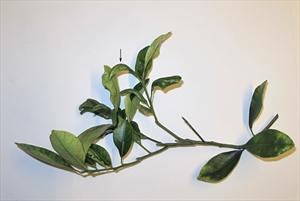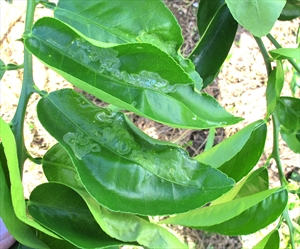Citrus leafminer
Pacific Pests, Pathogens, Weeds & Pesticides - Online edition
Pacific Pests, Pathogens, Weeds & Pesticides
Citrus leafminer (240)
Phyllocnistis citrella
Asia, Africa, North, South, and Central America, the Caribbean, Europe, Oceania. It is recorded from American Samoa, Australia, Guam, Federated States of Micronesia, New Caledonia, Northern Mariana Islands, Palau, Papua New Guinea, Samoa, Solomon Islands, Tonga, and Wallis & Futuna.
Most commonly, the leafminer attacks members of the citrus family, the Rutaceae, e.g. cumquat, grapefruit, lime, and sour orange. But other members of the Rutaceae are also hosts.
The leafminer larvae of the moth attack young leaves making tunnels or 'mines' under the surface layer of the leaf (Photos 1&2); this causes the young leaves to twist and distort as they grow (Photo 3). The edges of the leaves curl so that they become narrow, cupped or strap-like (Photo 4, arrowed), but they remain on the tree. The long (50-100 mm) irregular mines fill with air and this gives them a silvery or shiny appearance. They look as if a snail has crawled over the leaf. Generally, the mines are less common on the upper surface, and rarely cross the leaf midrib (Photos 5,6&7).
When moth populations are high, mines are also made in the stem of new shoots.
The flat, slightly oval eggs are about 0.3 mm long, and laid singly near the midrib of young leaves; they hatch in 1-2 days, and the larvae mine the leaves, feeding on sap released from cells broken apart by their toothed mouthparts. During the next 6-7 days the larvae pass through four stages; however, the last stage does not feed: it has mouthparts modified to make a chamber at the end of a mine which becomes covered with silk, and is protected by the rolled edge of the leaf (Photo 8). After about 6 days the adult moth emerges. It is silver-white, about 2 mm long, with a wingspan of 4 mm. Mating occurs soon after emergence, and females lay about 50 eggs in a life-span of 7-20 days.
Plants in nurseries and young transplanted trees are most affected by the leafminer. Death may result, but more usually infestations result in poor growth and fruit production. The damaged leaves stop growing, curl and become distorted. Damage also results from secondary attack by scale insects, mealybugs and mites that shelter in the deformed leaves.
There is evidence that citrus canker (see Fact Sheet no. 91), caused by a bacterium (Xanthomonas citri) is worse on trees infested by leafminers.
In recent years, and in places where trees are sprayed for other pests, the leafminer has become worse. In Florida, trees are sprayed against the Asian citrus psyllid, Diaphorina citri, which spreads greening or huanglongbing disease (see Fact Sheets nos. 185 & 230). The leafminer is not affected by pesticides as it is protected inside its mines.
Look for the winding, twisting mines, usually on the underside of young leaves; look for mines with a silvery appearance. The mines have a central line which is the excreta of the larvae.
Leafminers are generally difficult to control because they are protected inside the mines. Natural control with parasitoids is the most effective and efficient method.
NATURAL ENEMIES
About 50 species that are natural enemies have been reported to attack the citrus leafminer, many of which are chalcid wasps. Waterhouse1 lists the natural enemies that have been introduced worldwide, including Australia. There are four candidate parasitoids, and these are Ageniaspis citricola, Cirrospilus quadristriatus, Citrostichus phyllocnistoides and Semielacher petiolatus.
CULTURAL CONTROL
During growth:
- Remove badly affected shoots or just the leaves from nursery plants and trees, take them out of the nursery or plantation and destroyed them.
RESISTANT VARIETIES
Citrus species or varieties of citrus species show differences in susceptibility to citrus leafminer. However, this may not be due to differences between the hosts, but due to the production of tender shoots during times when populations of leafminer are seasonally low. Countries need to carry out tests.
CHEMICAL CONTROL
Highly toxic broad-spectrum pesticides are not recommended as they will destroy natural enemies of leafminers. They may also destroy other natural enemies of pests and cause outbreaks of scale insects and mites, for instance.
A better approach is to spray new growth with soap or pest oil; surfaces sprayed with oil deters egg-laying. Spray at the beginning of the main flush when the shoots are about 20-30 cm. However, soap and pest oils (petroleum or white oils) should not be used during times of hot sun (temperatures above 35oC), and it is good practice to test a few plants or trees before widespread use to make sure the pest oil is not toxic.
Small amounts of pest oil can be made with vegetable oil and household detergent (see Fact sheet no. 56). Pesticidal soaps can be made.
- White oil:
- 3 tablespoons (1/3 cup) cooking oil in 4 litres water.
- ½ teaspoon detergent soap.
- Shake well and use.
- Soap:
-
Use soap (pure soap, not detergent).
- 5 tablespoons of soap in 4 litres water, OR
- 2 tablespoons of dish washing liquid in 4 litres water.
-
Commercial horticultural oil can also be used. White oil, soap and horticultural oil sprays work by blocking the breathing holes of insects causing suffocation and death. Two or more sprays of soap and oils may be needed when new leaves are produced over an extended period.
____________________
When using a pesticide, always wear protective clothing and follow the instructions on the product label, such as dosage, timing of application, and pre-harvest interval. Recommendations will vary with the crop and system of cultivation. Expert advice on the most appropriate pesticides to use should always be sought from local agricultural authorities.
AUTHOR Grahame Jackson
Information from Waterhouse DF (1998) Biological Control of Insect Pests: Southeast Asian Prospects. ACIAR Monograph No. 51, 548 pp. Brown Prior Anderson, Melbourne; and Grafton-Cardwell EE et al. Citrus leafminer (undated). University of California Statewide IPM Program. Agriculture and Natural Resources, University of California. (http://ipm.ucanr.edu/PMG/PESTNOTES/pn74137.html); and from Citrus leafminer (2020) Agriculture and Food. Department of Primary Industries and Regional Development. Government of Western Australia. (https://www.agric.wa.gov.au/citrus/citrus-leafminer?page=0%2C1).
Produced with support from the Australian Centre for International Agricultural Research under project PC/2010/090: Strengthening integrated crop management research in the Pacific Islands in support of sustainable intensification of high-value crop production, implemented by the University of Queensland and the Secretariat of the Pacific Community.











